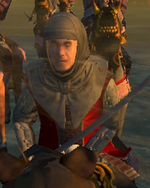
Kenshin Uesugi (18 February 1530 – 19 April 1578), born Kagetora Nagao, was the daimyo of the Uesugi clan and a Buddhist warrior monk. During his rule he fought against the Hojo, Imagawa, and Takeda in a series of wars over the Kanto region of eastern Central Japan, and he was known as the Dragon of Echigo or the God of War due to his power (the latter due to his worship of the Buddhist god of war Bishamonten).
Biography[]

Kagetora Nagao changed his name to adopt the Uesugi clan surname when he was appointed the Kanto Kanrei (Governor). He controlled the Uesugi clan after his father's death in 1543, but Harukage Nagao and his Nagao clan rebels attempted to overthrow Kenshin. Kenshin crushed this rebellion and began to expand the Uesugi clan after 1545. That year, he aided a coalition in their invasion of Sagami Province in the Siege of Kawagoe Castle, but his relative Tomosada Uesugi, the commander of the army, was killed and the Uesugi Coalition was routed.
Nevertheless, the Uesugi still were strong. Kenshin conquered Sado Island from the Honma clan in order to bolster their trade income and campaigned against the Ikko-Ikki warrior monks to the west and the Takeda, Imagawa, and Hojo to the south. In 1556 his army invading Suruga Province was dealt a defeat by the Takeda-Imagawa Alliance and the Hojo, who were fighting each other along the border of Sagami and Suruga. But in 1561, after the death of Yoshimoto Imagawa, Kenshin had to face only two other opponents: Shingen Takeda of Shinano Province and Ujiyasu Hojo of Sagami Province.

Kenshin at the Fourth Battle of Kawanakajima.
In 1561 Kenshin and Norimasa Yamanouchi, his relative, invaded the Kanto region and besieged Odawara castle, the capital of the Hojo clan. After a siege that left many dead on both sides (including the reinforcements of Shingen Takeda for the Hojo), Kenshin decided to withdraw. This inconclusive battle left Kenshin with the same situation he faced before the siege began. But this time, Shingen would strike first.
Three years later, Shingen Takeda amassed a huge army of Takeda cavalry and infantry and met Uesugi on the fields of Kawanakajima. This Battle of Kawanakajima was seen as a potential final battle for Kanto, with the two largest armies in central Japan meeting. 13,000 Uesugi met 20,000 Takeda in battle, and after a bloody fight between both armies, Kenshin was forced to retreat to the Zennkoji, where he later withdrew from the field. He had naginata warrior monks and arquebusiers, but failed to use them effectively. The crafty Shingen routed Kenshin and the two were forced to make peace. Shingen went on to besiege Odawara and lose at Mimase Pass in 1569 against the Hojo clan, while Kenshin campaigned against his other rivals.
In 1570 Kenshin was dealt a defeat at Tonegawa by an alliance of the Takeda and Hojo clans, so he made an alliance with the Hojo and Takeda in order to consolidate their strength and the peace of the Kanto. He and Shingen were freed to make a march on Kyoto but Shingen died during the siege in 1573 and Kenshin returned home. By that time, another warlord, Nobunaga Oda, had come to power in Owari and had made himself Shogun. In November 1577 Nobunaga invaded Echigo Province, the lands of Kenshin, so he mustered an army to face him at the Battle of Tedorigawa. Uesugi General Kanetsugu Naoe defeated a fire attack by Katsuie Shibata and rescued Kenshin's sister Aya from the attack, and Kenshin emerged victorious.
Nobunaga feared that Kenshin would march on Kyoto, so he offered to cede all of the northern provinces to him. However, he died of a seizure before he could do so, and the Uesugi remained in Echigo.
